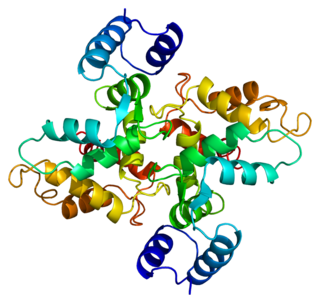
Neurocalcin is a neuronal calcium-binding protein that belongs to the neuronal calcium sensor (NCS) family of proteins. It expressed in mammalian brains. It possesses a Ca2+/myristoyl switch

Neuronal calcium sensor-1 (NCS-1) also known as frequenin homolog (Drosophila) (freq) is a protein that is encoded by the FREQ gene in humans. NCS-1 is a member of the neuronal calcium sensor family, a class of EF hand containing calcium-myristoyl-switch proteins.
Neuronal Calcium Sensor is a large family of proteins which work as calcium dependent molecular switches and includes members like Frequenin (NCS1), recoverin, GCAP, neurocalcin, visinin etc. All the members carry 4 EF hand motifs and an N-myristoyl group.
Nerve tissue is a biological molecule related to the function and maintenance of normal nervous tissue. An example would include, for example, the generation of myelin which insulates and protects nerves. These are typically calcium-binding proteins.

Calcium/calmodulin-dependent protein kinase type IV is an enzyme that in humans is encoded by the CAMK4 gene.

Glycylpeptide N-tetradecanoyltransferase 1 also known as myristoyl-CoA:protein N-myristoyltransferase 1 (NMT-1) is an enzyme that in humans is encoded by the NMT1 gene. It belongs to the protein N-terminal methyltransferase and glycylpeptide N-tetradecanoyltransferase family of enzymes.

Protein kinase C eta type is an enzyme that in humans is encoded by the PRKCH gene.

Calsenilin is a protein that in humans is encoded by the KCNIP3 gene.

HuD otherwise known as ELAV-like protein 4 is a protein that in humans is encoded by the ELAVL4 gene.

C-jun-amino-terminal kinase-interacting protein 3 is an enzyme that in humans is encoded by the MAPK8IP3 gene.

Visinin-like protein 1 is a protein that in humans is encoded by the VSNL1 gene.

Hippocalcin-like protein 1 is a protein that in humans is encoded by the HPCAL1 gene.

Baculoviral IAP repeat-containing protein 1 is a protein that in humans is encoded by the NAIP gene.

Disks large-associated protein 1 (DAP-1), also known as guanylate kinase-associated protein (GKAP), is a protein that in humans is encoded by the DLGAP1 gene. DAP-1 is known to be highly enriched in synaptosomal preparations of the brain, and present in the post-synaptic density.

DnaJ homolog subfamily C member 5, also known as cysteine string protein or CSP is a protein, that in humans encoded by the DNAJC5 gene. It was first described in 1990.

Calcium/calmodulin-dependent protein kinase kinase 2 is an enzyme that in humans is encoded by the CAMKK2 gene.

Kv channel-interacting protein 1 also known as KChIP1 is a protein that in humans is encoded by the KCNIP1 gene.

Homer protein homolog 2 is a protein that in humans is encoded by the HOMER2 gene.

Hippocalcin like 4, also known as HPCAL4, is a human gene.

Kv channel-interacting protein 4 is a protein that in humans is encoded by the KCNIP4 gene.



















